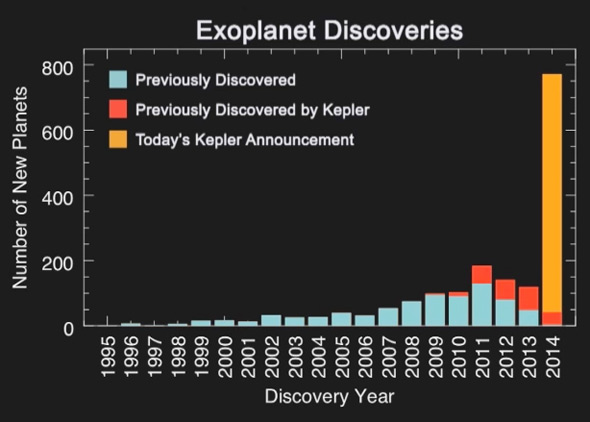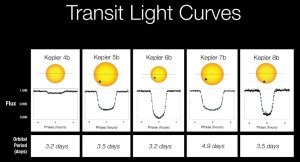

It seems like every other day, astronomers announce the discovery of a new exoplanet. As such, it’s natural to wonder how we manage to detect such planets against seemingly insurmountable odds. After all; space is incredibly large. In contrast, planets are quite small. Then, we must contend with the fact that the light they emit is faint compared to the parent stars they orbit.
In addition to the difficulty presented in detecting such a faint light source, the light from the planet’s parent star generally creates a glare that can wash the planet out and make it even more challenging to find. For those reasons, a very small fraction of the planets we’ve directly detected and observed have been terrestrial planets. The remainder of them are either gas or ice giants, with the equivalent mass of multiple Jupiter-sized bodies. So..
How Do We Spot These Planets?
In the olden days, we discovered planets by measuring a star’s position in the sky and watching to see how its position would change over time. Usually, this was done visually; with hand-written records, but thankfully, even though it’s still used in some scenarios, it’s typically a thing of the past. Now, we have a few different indirect methods; each with varying degrees of success. Perhaps the most ideal planetary detection method is the radial velocity method.
As is the case with the Sun and the other planets in our solar system, other stars with orbiting planets behave strangely in response to the planet’s gravity. Subsequently, the slight gravitational perturbations not only cause the star’s orbit to shift, but they lead to variations in the speed we see the star moving in when it travels towards or away from Earth. This, in turn, results in a displacement in the parent star’s spectral lines; otherwise known as the Doppler effect.
This phenomena essentially tells us vital information about he star by looking at the frequency of a wave relative to the source of the wave from an observer’s position. The radial velocity method measures these variations in order to confirm the presence of the planet, but it’s certainly not without disadvantages.
For starters, the method itself hinges on distance. It also needs to have signal-to-noise ratios that insure precision (meaning here must be little doubt that the signal is of planetary origin, instead of it merely being background noise). As such, astronomers typically only use this method when scouting planes that could be located within a bubble expanding 160 light-years beyond Earth. It can find massive planets that are close to stars with ease, but the detection and confirmation of planets found beyond this bubble may sometimes require many years of observation. Smaller planets are even more difficult, as it’s normal for the orbits of such planets to be highly inclined to our line of sight from Earth.
A Simpler Method:

For stars that are much farther away from us, we generally rely on the transit method. This isn’t the ideal method because it can’ exactly supply us with any information about the planets mass, but it does give us information about the radius of any orbiting planets. This works by observing the planet as it passes in front of its parent stars’ disk from our vantage point. When this happens, the planet obstructs a small amount of the star’s light. The amount of light that dims as this transit occurs is dependent upon the relative sizes of the star and any orbiting planet. Planetary transits are only observable for planets whose orbits happen to be perfectly aligned from our vantage point, so again, this is not the ideal method in planet hunting. However, it seemingly works best for scanning large areas of the sky with a multitude of stars at once.
In principle, transit surveys can find extrasolar planets at a rate that exceeds the amount discovered by the radial-velocity method. In fact,, the Kepler mission has detected over 2,000 candidates through utilizing this method so far, but it too has its own set of problems.
One disadvantage to using this method is the difficulty it has in finding smaller, terrestrial planets. Since they are smaller than hot-Jupiter exoplanets, which always orbit their parent star from a very close distance, the light they obstruct is smaller and thus more difficult to detect. As are the wobbles they produce.
One advantage lies in the fact that it provides us with the planet’s transmission spectrum (telling us things about its chemical composition and atmosphere). We record this information when the planet passes in front of the star. If the planet has no atmosphere, it will block the same amount of light at all wavelengths, if it does have one, gasses in the atmosphere will absorb additional light. You then divide the two numbers and you get the planet’s atmospheric transmission spectrum. This is no easy feat since the light blocked by the planet is mere percentages of the star’s total light.
Newer Methods:
In recent years, astronomers have concocted several new ways we can suss out other planets. The methods include stellar fingerprinting, which looks at the chemical composition of stars to see if it contains a decent amount of iron and other heavier elements. Current models (along with observation) tell us that most heavy elements and compounds are locked up in rocky bodies following the formation of planetary systems. Even more-so when protoplanets are involved. They are born once they accrete enough heavy material for a planet to coalesce; meaning that the material doesn’t make its way into stars, leaving them anemic (so to speak). Thus, scientists can merely view the chemical compositin of the star, looking to see just how much heavy elements individual stars have. The more, the less likely a planet was born. Less and the likelihood is greater, which gives astronomers a starting point.
We’e already seen this method in action when it led to. the discovery of a planet in the Alpha Centauri system. Either way, one thing is for sure; it gives astronomers the ability to discount observing stars with a lot of heavy material in favor of those with low metal-content (great news since the process of discovering a single planet is generally long and fraught). No doubt even more effective methods will come along later though.
For More Information: Hunting for Planets